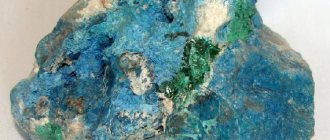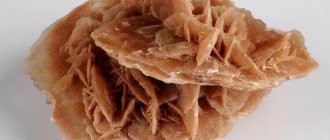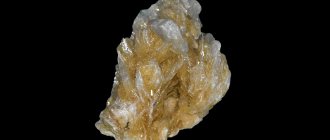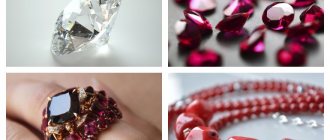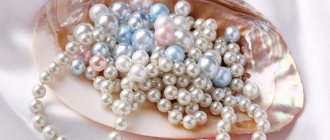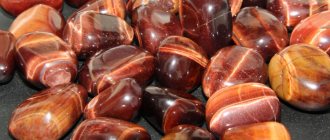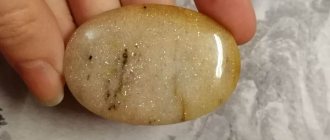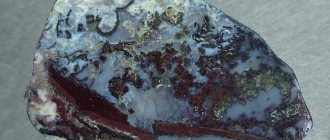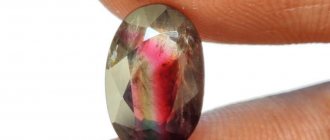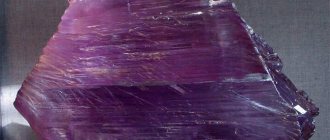Story. Origin
Colorless or slightly colored anhydrite was valued in ancient times. Egyptian and Roman artisans made vases and lamps from it. Sometimes anhydrite tiles were used to line the walls of residential buildings. In the 19th century and early 20th century, writing instruments made from anhydrite were popular.
In 1804, this mineral was studied in detail by the German scientist Abraham Werner, who proposed calling it anhydrite (translated from Greek as “deprived of water”).
After some time, another name for the stone appeared - angelite (from the Greek “aggelos” - angel). This brand of mineral arose because of its color, reminiscent of the blue of the sky, covered with haze. Then, due to the fact that the extraction of blue stones is limited, anhydrites of other colors began to be called angelites: whitish, gray, purple, reddish and milky minerals.
This stone is also called karstenite. This name was given to it because of its origin. The fact is that as a result of dehydration of gypsum, caverns and karsts are formed in its deposits - underground cavities in which anhydrite (karstenite) is found. After all, this mineral is dehydrated gypsum.
Jewelry with mineral
Anhydrite, as a jewelry raw material, is little known within Russia. Abroad, on the contrary, this mineral is successfully used to make jewelry.
The most popular is blue Peruvian anhydrite, also known as angelite. Italians love this mineral - the stone can be successfully polished, making beautiful beads and cabochons. Products with this stone look gentle and sophisticated. Prices for such jewelry are more than affordable:
- a pendant made of Peruvian stone starts from 450 rubles;
- earrings can be bought for 800-900 rubles.
Beads from Angelite
Beads for needlework are sold even cheaper. Handmakers use them to create beads and bracelets.
Do you know that the name “angelite” came only in 1987? This is purely a trade name for one of the varieties of anhydrite. In the magical world, angelite is considered a heavenly stone. When a person needs help, it is necessary to turn to the stone with the following words: “My angel, be with me. You are ahead, and I am behind you."
Due to the rarity of the mineral, as well as its fragility, jewelry with angelite is rare. The frames are inexpensive metals - bronze, cupronickel, brass, and occasionally silver. Carved figurines or icons in the form of angels are popular among Catholics.
Also read: Diorite - features of volcanic rock
Physicochemical characteristics
Anhydrite is a modification of anhydrous calcium sulfate. Upon contact with water, the mineral increases in volume and gradually turns into gypsum.
- Chemical formula - CaSO4 .
- Color - white, blue, bluish-gray, sometimes gray-violet, red-violet, red.
- The shine is glassy, greasy, pearlescent.
- Transparency - opaque or translucent; there are also transparent stones.
- Hardness - 3,0–3,5.
- Density - 2.8–3.0 g /cm3 .
It does not decompose in hydrochloric acid.
Description of anhydrite
Anhydrite is a sedimentary rock mineral of the anhydrous sulfate class. A stone with a pearly or oily sheen, transparent or not translucent. There is pleochroism. Formed at high temperatures. They are often found near salty bodies of water. They are mined in the Alps, Donbass, Mexico, Peru, and Canada.
Available in color:
- baby blue;
- pink;
- red;
- grey;
- snow white;
- lactic;
- lilac;
- violet;
- bicolor (red + blue, purple + pink, other variations).
Anhydrite has been known since the times of Ancient Rome and Egypt. They find bas-reliefs, boxes, and other decorative items.
There are imitation stones. Water helps distinguish fakes from natural anhydrite. A cheap analogue does not absorb moisture, and the natural mineral loses its hardness and becomes limp.
Watch a short video about the mineral:
Place of Birth
There are not very many anhydrite deposits on the planet; they are concentrated in Europe and America. Significant reserves of this stone are located in Peru, the USA, Switzerland, and Germany. There are deposits in Chile, Mexico, Canada, Iran, Italy, Russia (for example, the Norilsk Anhydrite mine; the subpolar Urals).
Peruvian anhydrites began to be found since 1987 , they accompanied other minerals: calcite, halite, dolomite, gypsum, etc. Minerals from Peru are very valuable: they have a soft blue color, high density, the size of these fine-grained aggregates is more than 10 cm .
Anhydrite. Properties and uses of anhydrite
It dilutes well in ether, but is poorly soluble in water. This is the property of anhydrite. This is a chemical compound in the form of a liquid with a pungent odor.
There are different types of substances - acetic, phosphoric, phthalic anhydrite. The latter, for example, is widely used as plasticizers for polymer materials. At one time, the vinegar type was used for the production of heroin. The chemical reagent helps to obtain acetylated opium from regular opium.
In fact, any anhydrite is a combination of some element with oxygen. The substance is obtained by removing water from various acids. Such is calcium oxide - a solid form of anhydrite. This is a mineral, a special gypsum. Let's figure out why it's special.
Gypsum anhydrite is
In rock anhydrite, calcium oxide is combined with sulfur trioxide, that is, the mineral formula is CaSO4. Sometimes the composition contains an admixture of strontium or cobalt. Accordingly, the color becomes cobalt gray, pale blue, with a purple tint. There are reddish specimens. But, most often found is white and slightly grayish gypsum anhydrite .
The mineral has a greasy, glassy sheen. During fractures, pearlescent radiation appears on the planes of fusion. The increased refraction of light is sometimes facilitated by the complete transparency of the anhydrite. The formula of the stone allows it to be equally watery-transparent and cloudy. But there is no completely matte type of plaster.
On the Mohs scale, stone, like any gypsum, has a hardness of 3-4 points. For comparison, apatite has 5 points. You can scratch it with a knife, but you will have to make an effort. Plaster scratches relatively easily.
Anhydrite formation
If anhydrite solutions are man-made, then the mineral variation is formed in nature. The stone is sedimentary, that is, the components fall out of solutions, settle on surfaces and are compressed. Typically, anhydrite is found in salt deposits in combination with ordinary gypsum. Rarely is the exhalative version of the mineral found, that is, precipitated from gases. Such crystals are found in the voids of volcanic vents.
anhydrite most often originates from salt solutions, they look for the stone in salt deposits. In Russia, deposits are being developed on the Taimyr Peninsula and in the Urals. Many clusters have been found in Germany. Why is special gypsum mined?
Applications of anhydrite
The decomposition of anhydrite is a source of sulfuric acid. Low-grade mineral samples are used to obtain it. The rest of the stone is given to the construction industry. Basically, blocks are used as finishing material and raw material for the formation of cement.
In the latter, gypsum is added due to its ability to absorb water. But this ability of the mineral interferes with finishing. The stone is not suitable for placement in bathrooms, swimming pools and other rooms with high humidity.
Anhydrite is also useful in crafts. The stone is easy to process, but strong enough for large volumes of figurines, vases, and boxes. There is even a jewelry, purple variety of anhydrite. It is mined in Canada, in the Ontario deposit.
From here, gypsum can easily be cut into different cuts. The Peruvian mineral is also valued in jewelry. It is also easily cut and has a rare blue-red color.
Magical and healing properties of anhydrite
Lithotherapists specialize in treatment with stones. They claim that anhydrite can improve memory. Therefore, the mineral is “prescribed”, for example, for people with Alzheimer’s disease. Crystals will not interfere with those who are simply absent-minded, or who are forced to keep a large amount of information in their heads.
Anhydrite is also recommended for fevers, headaches and toothaches. The mineral is kept close to the problem area. So, for migraines, buy earrings with a compound of calcium oxide and sulfur trioxide. Neck pendants are worn for diseases of the thyroid gland. In rings, lithotherapists believe, anhydrite has a beneficial effect on the functioning of the gastrointestinal tract.
Anhydrite is often found near mineral springs and is a source of ions for them. Doctors recommend getting a stone crystal and throwing it into a glass of water every day. By drinking it, you cleanse your body of toxins. Astrologers add that this is best done by those born under the sign of Libra and Aquarius.
Application
Anhydrite is used in several applications. Each of them requires raw materials of a certain quality.
Jewelry
According to the jewelry classification, angelite is an ornamental stone, but single craftsmen make jewelry from this mineral. True, due to the fragility of the stone, their range is limited: beads, pendants, pendants, earrings, brooch inserts. Products that experience mechanical stress (cufflinks, rings, bracelets) are rarely made from angelite.
In jewelry, angelite is sometimes combined with gems comparable in jewelry value, for example, jasper, quartz, rauchtopaz, serpentine, and coral.
Decor
This is the main area of use of angelite. Master stone-cutters value the mineral for its beauty, decorativeness, and ease of processing. They make small plastic items, eggs, pyramids, boxes, and tableware from it. Protective amulets made of angelite and figurines of angels are especially popular.
Collecting
Collectors of mineralogical collections appreciate unusual stone specimens. Intergrowths of reddish or blue anhydrite with other minerals: gypsum, dolomite, calcite, halite are especially in demand.
Other areas
Anhydrite arrays of ordinary characteristics are the source material for interior cladding.
Crumbs and other substandard materials are used in the production of cement, sulfuric acid and other sulfur compounds.
Farmers use anhydrite (along with gypsum) to cultivate saline lands.
Areas of application of stone
In ancient times, anhydrite was considered a popular stone among artisans. Plates made from it were widely used for wall cladding. Modern builders claim that the mineral is not suitable for finishing buildings, as it is afraid of moisture. In industry, anhydrite-cement mixtures and sulfuric acid are produced based on anhydrous sulfate.
Due to its softness, anhydrite is widely used by designers. Decorative items are made from stone, including figurines, figurines, vases, lamps and other interior decorations.
Jewelers also fell in love with the mineral. Anhydrite inserts of various colors often decorate inexpensive designer products; their affordability makes them in demand on the costume jewelry market.
The physical properties of anhydrous sulfate make it possible to use it in the cultivation of saline lands.
Anhydrite is sensitive to environmental conditions. To prevent the stone from turning into plaster, it should not be wetted or kept in a room with high humidity for a long time. With proper care and periodic recharging, the crystal will become a faithful assistant and source of energy for creative people.
Medicinal properties
Anhydrite shows its healing power in the prevention of diseases. Due to the presence of sulfate ions in the stone, the following healing properties appear when worn:
- strengthening the immune system, tidying up the human aura;
- resistance to infections;
- accelerating recovery of health after serious illnesses.
Only natural anhydrite has medicinal and magical significance for humans, and the stone must be whole.
It is believed that the mineral can relieve its owner from toothache and alleviate migraines. To do this, it is better to wear it as an insert in earrings.
Lithotherapists claim that anhydrite helps forgetful people increase attention and improve memory.
They also advise drinking 1 glass of water daily, in which this stone was kept for several hours. If you do this regularly, the body will be cleansed of toxins.
Anhydrite
ANHYDRITE
Anhydrite formula CaSO4. Chemical composition of anhydrite: calcium oxide (CaO) - 41.2%, sulfur trioxide (S03) - 58.8%, strontium is often found as an impurity. The hardness of anhydrite on the Mohs scale is 3-3.5. Translated from Greek, anhydrite is hydor - “water”, an - a prefix of negation. Therefore, the name of the stone emphasizes that it is a mineral devoid of water. Indeed, anhydrite is anhydrous calcium sulfate. If you add water to it, it increases in volume by about 30% and gradually turns into gypsum. Anhydrite deposits are formed in sedimentary strata as a result of dehydration of gypsum deposits.
Physical properties: a) color: gray, white, pale blue, cobalt blue, violet, pale red. b) luster: glassy, greasy, pearlescent on the cleavage planes. c) transparency: transparent, water-transparent, cloudy. d) line: white. e) hardness: 3 - 4. f) density: 2.9 - 3. g) fracture: brittle. h) system: rhombic. i) shape of crystalline precipitates: thick-tabular, cubic, short-columnar crystals; For the most part, anhydrite forms continuous masses.
Features of education. It is predominantly a chemogenic sedimentary mineral and is found in salt deposits with gypsum, rock salt, and carnallite; less commonly, anhydrite is formed hydrothermally. Sometimes found as an exhalation mineral in lava voids.
Associated minerals: gypsum, rock salt, sylvite, carnallite Related minerals: cryolite, gypsum, barite, calcite.
Place of Birth. First of all, in the areas of salt deposits in the Southern Harz, in the area of the Werra River, near Stasfurt, in Hesse near Hannover and in other areas (Germany); in the Urals and on the Taimyr Peninsula (Russia).
Anhydrite is a common ornamental stone, in hardness it occupies an intermediate position between jasper, jades and agates on the one hand and soft selenite and calcite on the other. Anhydrite can be white, bluish, grayish, or less often reddish. The bluish anhydrite is highly polished; It has long been used in Lombardy (Italy) instead of marble. Until the 17th century ornamental colored stone was not mined in Russia, but was brought mainly from Byzantium, Central Asia and various countries of Western Europe. The first cutting factory was founded in 1725 by decree of Peter I in Peterhof, where various ornamental stones were brought from all over Russia. Since then, a variety of products have often been cut from anhydrite.
White-pink or bluish anhydride is “heavenly stone”, it is also called “Nizhny Novgorod marble”. Natural alabaster of soft yellow and pink shades, with soft transparency, elegant pattern of fancy stains and spots.
Magical properties of anhydrite. An anhydrite talisman or amulet helps its owner in everything, and the shape of the stone influences the enhancement of the magical properties of the stone. Thus, an anhydrite figurine in the shape of a nightingale or a swan will attract love, and a rabbit figurine will bestow the favor of the authorities. It is also believed that anhydrite helps creative people well - it develops creative abilities and enhances inspiration.
The healing properties of anhydrite. This gem relieves headaches and dental pain well, and will help with migraines. It is also believed that anhydrite is a good treatment for diseases of the throat and thyroid gland.
Anhydrite was first described in 1804 by the German mineralogist A. Werner. Despite this, the mineral has been known as an ornamental and facing stone since ancient times under other names. It was used in construction in Egypt; fortunately, the stone was well preserved in the hot and dry climate. In particular, the same Egyptian pyramids were lined with anhydrite on the outside for decorative purposes. During the Roman Empire, anhydrite was used as an ornamental stone along with gypsum for the manufacture of large products and in construction as a substitute for marble. Significant deposits of this mineral are known in Italy.
From antiquity to the present day, anhydrite has been used primarily for sculpture and carved bas-reliefs - the stone lends itself well to polishing and carving. In the 19th century, writing instruments began to be made from it.
In Russia, until the 18th century, stone was imported. The anhydrite industry was started by Peter the Great. Later, anhydrite began to be mined from the Urals and the Taimyr Peninsula, and not only used for facing materials, but also for carved figures.
Ornamental anhydrite is used to make figurines and sculptures, not even small mosaic paintings. It is used by folk stone carvers to create their unique products. Their cost no longer depends on the stone itself, but on the skill of the author and the amount of work. Anhydrite is also used to make boxes and other small decor. You can find products in a wide price range: from 500 rubles to 30,000 for a large carved product (person size) and even up to 250,000 for a sculptural group. Small carved anhydrite can be found in the souvenir shop, but large items are made exclusively to order.
Collectors will find interesting rare translucent cut anhydrite crystals and beautifully colored, regular anhydrite druses.
Anhydrite or as it was called “Nizhny Novgorod marble”. It comes in a variety of shades: pink, white, bluish, brown, gray and greenish, with a variety of designs and patterns. During the time of Catherine II, the stone was sent to St. Petersburg for decoration of palaces. The heyday of Borukovo stone-cutting art occurred in the 30s of the 20th century, when in the village. In Bornukovo, a factory of artistic stone-cutting products “Bornukovskaya Cave” was created. At first she worked as a branch of the Kazakovsky Jewelry Association, then independently. A few years later, having adopted the experience of the Ural masters, Bornukovo stone carvers reached the pinnacle of skill and were repeatedly awarded the highest awards at Russian and international exhibitions, including the 1937 exhibition in Paris.
Soft stone carving is one of the most complex areas of modern decorative art, and among the stone-cutting crafts of Russia, rare masters have an individual creative personality, continuing the traditions of the animalistic genre in Russian folk art. When processing stone, turning is used in combination with volumetric and relief carvings and engraving. Samples of animals and birds are distinguished by their laconicism and at the same time unique “characters”, which allow us to reveal the natural beauty of the material. The expressive silhouette, soft plasticity, lyricism, and ingenuousness of the created samples convey the beauty and originality of the animal world and the kindness of the Russian soul.
In addition to sculptures of birds and animals, the company’s craftsmen produce a wide range of household items: elegant candlesticks, vases, boxes, writing sets.
Applications. Anhydrite (like gypsum) is used as a raw material for the production of sulfuric acid and as a building material (binder).
Now anhydrite is used in bulk in the construction industry for concrete and dry building mixtures, and in the paper industry. Gypsum factories consider it as a semi-finished product.
Uostrov (Russia).
Magic properties
Opinions differ about the magical properties of anhydrite.
Angel Stone
Magicians consider these gems to be “bridges” between people and guardian angels. To establish contact with his heavenly patron, the owner of the stone needs to read a spell or ask an angel to fulfill a wish.
The Guardian Angel fulfills only one wish transmitted through this gem. For the next one you need another pebble.
Christian priests believe that such an influence of the mineral does not exist, since blue anhydrite is called angelite by marketers in order to be more attractive to buyers.
Western esotericists advise recharging this stone under the rays of the Sun, the light of the Moon and stars, so that the angelite quickly gets used to the owner and the world of light.
Other options
The magic of anhydrite also manifests itself in a more mundane sphere:
- Helps create balance between the physical body and aura.
- Calms excessive emotions, removes nervousness. A person does not pay attention to minor troubles and begins to simply enjoy life.
- Helps shy people express themselves in communication, business, and creativity.
- With its help, an overly self-critical owner will be able to forgive himself for past mistakes and get rid of self-criticism.
- Aggressive and callous people will become more loyal to others.
- The stone tells you how to solve problems, get out of difficult situations, and also how to start a new project.
Esotericists believe that this gem establishes a connection with the wisdom of the Universe, with true knowledge. Some claim that the magical properties of angelite can help one gain the ability to communicate over a distance.
Angelite is considered the embodiment of goodness, so the owner of the mineral must be a person with positive qualities. If he is not ready to work on himself in order for negative character traits to disappear, then it is better not to wear this stone, otherwise punishment from higher powers is possible - this is what some esotericists say.
A talisman or amulet in the form of a bird (swan, nightingale, stork) will attract love and friendship to the owner of the gem, and relieve fatigue and irritation.
Restrictions
Lithotherapists recommend not wearing jewelry with angelite all the time. Although the influence of this stone is positive, it manifests itself too persistently, so the owner may become disorganized and childish.
It is best to take this mineral with you or wear jewelry with it before important events to remain calm and balanced.
Magic abilities
While healers advise the constant use of the mineral for medicinal purposes, esotericists warn against systematic contact with anhydrite. The fact is that the powerful energy of a gem, while working for the benefit of a person, still somewhere acts to his detriment.
The talisman dampens the owner’s sense of purpose. This becomes the cause of personal inaction, as the comfort zone narrows and problems become less pressing. A person closes himself inside this shell, not wanting to change anything for the better.
Also read: Rhodonite - the semi-precious wealth of the Ural Mountains
Magicians claim that there is still magic in this stone. An anhydrite amulet protects against troubles, makes a person calmer, and gives courage and honesty. By transferring all the lunar power to a person, the gem will help preserve the fire of love between lovers. The main thing to remember is that you can carry a stone with you only in rare cases that require it, but not all the time.
It is important to know! The anhydrite talisman works as a powerful amulet for a newborn baby. The stone will not only protect the child from negativity, but will also help raise a kind person with good intentions.
It is appropriate to keep souvenirs made from anhydrite at home. Moreover, each of them has its own role. Figurines of animals such as a squirrel or a rabbit (hare) help build a career. Silhouettes of swans, a nightingale or a stork are assistants in love affairs. An ordinary raw anhydrite crystal will attract fame and success to the owner of the house.
Who is suitable according to their zodiac sign?
Anhydrite has light energy, it has a beneficial effect on all signs of the zodiac. The gem is especially suitable for Virgo and Pisces . With its help, the personality potential of representatives of these signs will be fully revealed.
Under the influence of angelite:
- Cancer will be able to become more confident in their strengths and abilities.
- Overly emotional Geminis will become calmer.
- Leo will moderate his ardor.
- Scorpio will be more balanced.
- Sagittarius will feel a surge of energy.
- Aries and Libra will find faithful partners in business.
- Aquarius will not commit rash actions and this will protect them from failures.
- For Taurus and Capricorn , angelite will become an effective talisman of good luck.
How to wear and care
When caring for this stone, you should take into account its properties (hydrophobia, fragility, low hardness):
- The main rule is to protect anhydrite from moisture. You cannot wear jewelry with it to the beach, to the pool, or in rainy weather. You can’t even wear it on your naked body, as sweat will gradually destroy the pebble.
Anhydrite that has absorbed moisture turns into gypsum.
- The stone must be protected from mechanical stress.
- It should be stored in a separate tightly closed box or box.
- Cleaning with abrasives and strong chemicals is prohibited.
- This gem cannot be cleaned with water. To prevent dirt from accumulating, after use you need to wipe it with a slightly damp cloth and immediately wipe it dry.
Moisture that penetrates into the stone changes its structure, increases its volume and, as a result, turns it into cracked gypsum.
Anhydrite. Description and properties of the mineral
The name of this stone comes from the Greek word hydor
,
which translates as “water”, and the negative particle a n, i.e.
anhydor
is translated as “deprived of water.”
Stone is a very common ornamental material. In terms of its hardness, it is between jade, agate and jasper, on the one hand, and calcite and selenite, on the other.
Anhydrite is an anhydrous calcium sulfate, the hardness of which is 3.0-3.5.
Anhydrite deposits are usually formed in sedimentary strata as a result of dehydration of gypsum, which means that if you add water to this mineral, it can increase in volume and gradually turn into gypsum.
This mineral is mined mainly in the areas of salt deposits in Germany (Southern Harz, area of the Werra River, near Strasfurt, etc.), as well as in Russia, in the Urals and on the Taimyr Peninsula.
In terms of its hardness, this mineral occupies an intermediate place between jasper and agates. Some translucent anhydride samples are suitable for cutting. Typically, this stone is used for cutting various figures and figurines. Anhydrite with a bluish tint looks very beautiful, resembling pieces of ice.
The color of this mineral can be very diverse. In nature, stones of white, bluish and grayish colors are found. Not often, but you can still find minerals of a reddish hue.
In China, it is believed that this stone is endowed with the same magical properties as selenite, jasper and jade.
Just like selenite, anhydrite helps reduce the influence of the dark Moon and attracts the friendly disposition, sympathy and love of others to its owner. In addition, it helps fight fatigue and irritation.
Like jade, this mineral makes its owner brave, fair and courageous. In addition, anhydrite, like jasper, protects against evil rock and helps create good relationships with high-ranking people.
Anhydrite is suitable for any zodiac sign, but you need to remember that the stone needs recharging. Therefore, on full moon days, anhydrite should be placed on the windowsill, covered with a purple cloth and left overnight.
It is believed that anhydrite improves memory and helps start new periods in life. During meditation, a piece of anhydrite will be useful. Lithotherapists believe that this mineral helps to resolve “energy blockages or traffic jams” in the body of its owner.
This suggests that anhydrite improves vascular and capillary blood flow, and also promotes muscle relaxation. A massage using polished anhydrite will restore a person's hormonal balance.
Despite the fact that the stone is an indispensable assistant for a person, experts do not recommend constantly wearing it in the form of jewelry, as it can make its owner careless and absent-minded. That is why astrologers recommend not wearing anhydrite, but decorating your home with figurines from it.
How to distinguish from a fake
Anhydrite is often replaced with plastic. To avoid buying a fake, you need to:
- Carefully examine the gem. Natural stone is rough and has inclusions of other rocks. Glassy veins are often present. The surface is almost always chipped or cracked.
- Remember that a fake can be identified by uniform color or pattern and a very smooth surface.
- Hold a pebble in your hand: natural stone will take a long time to heat up, while plastic will heat up almost immediately.
- Estimate weight: the stone is heavier than the plastic fake.
The authenticity of anhydrite is of particular importance for a person who wants to make the stone his amulet or talisman.
In salons or shops of esoteric paraphernalia you can buy anhydrite, equipped with a certificate of quality.
Runet sites offer jewelry made from this mineral, made by hand-made craftsmen, as well as collectible material.
Price
The cost of angelite or products with it in Russian online stores is relatively affordable (price in rubles) :
- stone from Peru (67x48x39 mm, 200 g) - 2500;
- ball (65 mm) — 6100;
- bead (4–14 mm) — 25–105;
- silver earrings) - 3200;
- pendant (50 mm, silver, leather cord) — 1500.
Jewelry is offered by craftsmen in a single copy, or their quantity is limited.
Read also: Belomorite - a stone donated by the North
